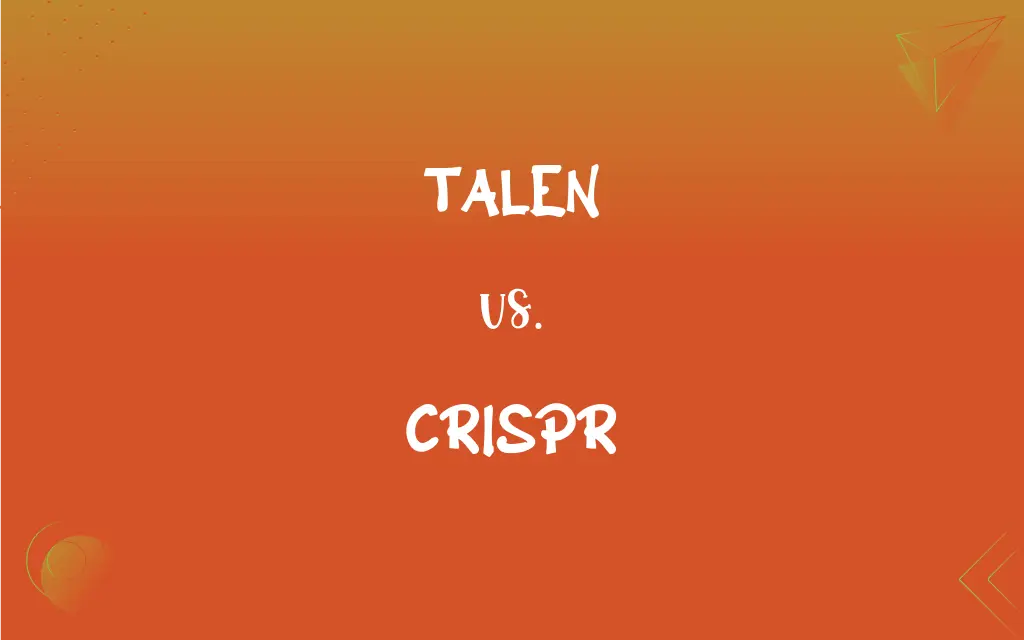TALEN vs. CRISPR: What's the Difference?
Edited by Aimie Carlson || By Harlon Moss || Published on February 14, 2024
TALEN (Transcription Activator-Like Effector Nucleases) and CRISPR (Clustered Regularly Interspaced Short Palindromic Repeats) are both gene-editing tools; TALEN uses protein-based DNA recognition, CRISPR utilizes RNA-guided targeting.

Key Differences
TALEN and CRISPR are revolutionary technologies in genetic engineering. TALEN, which stands for Transcription Activator-Like Effector Nucleases, uses a protein-based system to bind to specific DNA sequences. In contrast, CRISPR, or Clustered Regularly Interspaced Short Palindromic Repeats, employs an RNA-guided method for DNA targeting, making it generally more flexible and easier to design.
The precision of gene editing is a key difference between TALEN and CRISPR. TALENs are highly precise due to their protein-DNA interaction mechanism. CRISPR, while also precise, occasionally faces issues with off-target effects due to its reliance on RNA-DNA base pairing.
In terms of ease of use, CRISPR holds an advantage over TALEN. The design and construction of CRISPR systems are simpler and more cost-effective, primarily because RNA guides are easier to produce than the custom proteins required for TALEN.
The adaptability of CRISPR is broader than that of TALEN. CRISPR's simple guide RNA can be easily modified, allowing for multiplex gene editing. TALEN, with its protein-based architecture, requires more complex engineering for targeting multiple genes.
Both TALEN and CRISPR have made significant impacts in biotechnology and medicine, though CRISPR has gained more popularity due to its ease of use and adaptability. However, TALEN remains relevant for applications requiring higher specificity.
ADVERTISEMENT
Comparison Chart
Definition
Transcription Activator-Like Effector Nucleases
Clustered Regularly Interspaced Short Palindromic Repeats
Targeting Mechanism
Protein-based DNA recognition
RNA-guided DNA targeting
Precision
High, due to protein-DNA interaction
High, but can have off-target effects
Ease of Design and Use
Complex, requires custom protein engineering
Simpler, uses easily modifiable RNA guides
Application Flexibility
Less adaptable, challenging for multiplexing
Highly adaptable, suitable for multiplexing
ADVERTISEMENT
TALEN and CRISPR Definitions
TALEN
TALEN operates by binding to specific DNA sequences and cutting the DNA.
Scientists used TALEN to cut a DNA sequence associated with cancer.
CRISPR
CRISPR's adaptability makes it suitable for multiplex gene editing.
Scientists applied CRISPR to simultaneously edit multiple genes in a single cell.
TALEN
TALEN is used in therapeutic research for correcting genetic disorders.
A TALEN-based therapy is being developed to treat a rare genetic eye disease.
CRISPR
CRISPR technology is pivotal in gene therapy and agricultural biotechnology.
CRISPR is being explored to create drought-resistant crop varieties.
TALEN
TALEN technology allows for targeted gene disruption and insertion.
TALEN was employed to insert a beneficial gene into a crop plant's genome.
CRISPR
CRISPR is a genome editing technology that allows for precise DNA alteration.
CRISPR was used to modify the genome of a mouse to study diabetes.
TALEN
TALEN is a genetic engineering tool for precise DNA modification.
Researchers used TALEN to correct the genetic mutation causing sickle cell anemia.
CRISPR
CRISPR uses RNA-guided enzymes like Cas9 to target specific DNA sequences.
In their experiment, researchers utilized CRISPR-Cas9 to target a viral gene.
TALEN
TALEN consists of customizable proteins for targeted gene editing.
The team designed a specific TALEN protein to study gene function in zebrafish.
CRISPR
CRISPR can be used for gene knockout, insertion, and regulation.
Using CRISPR, a gene responsible for a hereditary disorder was knocked out.
FAQs
Can TALEN and CRISPR edit multiple genes at once?
CRISPR is better suited for multiplex gene editing, whereas TALEN is less adaptable for this purpose.
Is CRISPR more accurate than TALEN?
Both are accurate, but TALEN generally has fewer off-target effects compared to CRISPR.
What is TALEN?
TALEN is a gene-editing tool using protein-based DNA recognition for targeted genetic modifications.
What does CRISPR stand for?
CRISPR stands for Clustered Regularly Interspaced Short Palindromic Repeats, a system for genome editing.
Are TALEN and CRISPR technologies safe?
Both technologies are considered safe but require thorough testing for specific applications, especially in clinical settings.
How cost-effective are TALEN and CRISPR?
CRISPR is generally more cost-effective due to simpler design and implementation.
What are the ethical considerations for TALEN and CRISPR?
Ethical concerns include potential misuse, germline editing, and long-term impacts on ecosystems and human health.
What makes CRISPR more popular than TALEN?
CRISPR's ease of use, adaptability, and lower cost contribute to its popularity over TALEN.
How does TALEN differ from CRISPR in targeting DNA?
TALEN uses protein-based DNA recognition, while CRISPR employs RNA-guided targeting.
How do researchers choose between TALEN and CRISPR?
The choice depends on the specific requirements of precision, multiplexing capability, and experimental ease.
How do TALEN and CRISPR impact research?
They have revolutionized genetic research by enabling precise and efficient genome editing.
Can TALEN and CRISPR cause unintended genetic changes?
Yes, though rare, unintended changes can occur, necessitating careful design and testing.
What applications are TALEN and CRISPR used for?
Both are used in biomedical research, gene therapy, and agriculture, but CRISPR is more widely adopted due to its versatility.
Can TALEN and CRISPR cure genetic diseases?
They have the potential to treat genetic diseases, but clinical applications are still in development.
Can TALEN and CRISPR be used in humans?
Yes, but under strict regulatory guidelines and primarily for research and therapeutic development.
Are there any limitations to using TALEN and CRISPR?
Limitations include potential off-target effects, delivery challenges, and varying efficiency across different cell types.
What is the future potential of TALEN and CRISPR?
They hold promise for advanced gene therapies, improved agricultural practices, and furthering basic scientific research.
How do TALEN and CRISPR contribute to agriculture?
They are used to create genetically modified crops with improved traits like disease resistance and yield.
Are TALEN and CRISPR natural processes?
Both are engineered based on natural processes: TALEN from bacterial TAL effectors and CRISPR from bacterial immune systems.
Can TALEN and CRISPR be used in all organisms?
They are broadly applicable but may require specific tailoring for different organisms.
About Author
Written by
Harlon MossHarlon is a seasoned quality moderator and accomplished content writer for Difference Wiki. An alumnus of the prestigious University of California, he earned his degree in Computer Science. Leveraging his academic background, Harlon brings a meticulous and informed perspective to his work, ensuring content accuracy and excellence.
Edited by
Aimie CarlsonAimie Carlson, holding a master's degree in English literature, is a fervent English language enthusiast. She lends her writing talents to Difference Wiki, a prominent website that specializes in comparisons, offering readers insightful analyses that both captivate and inform.







































































